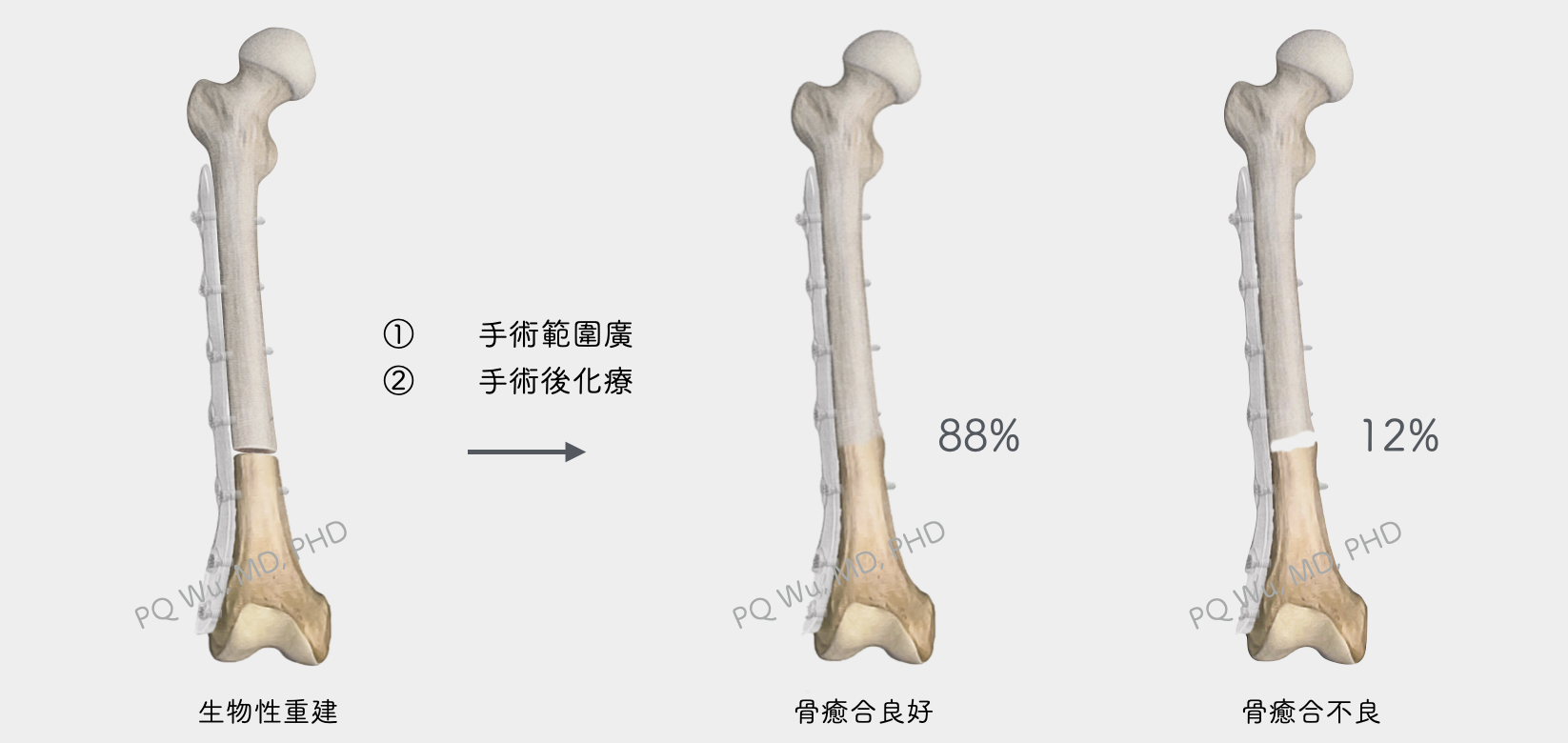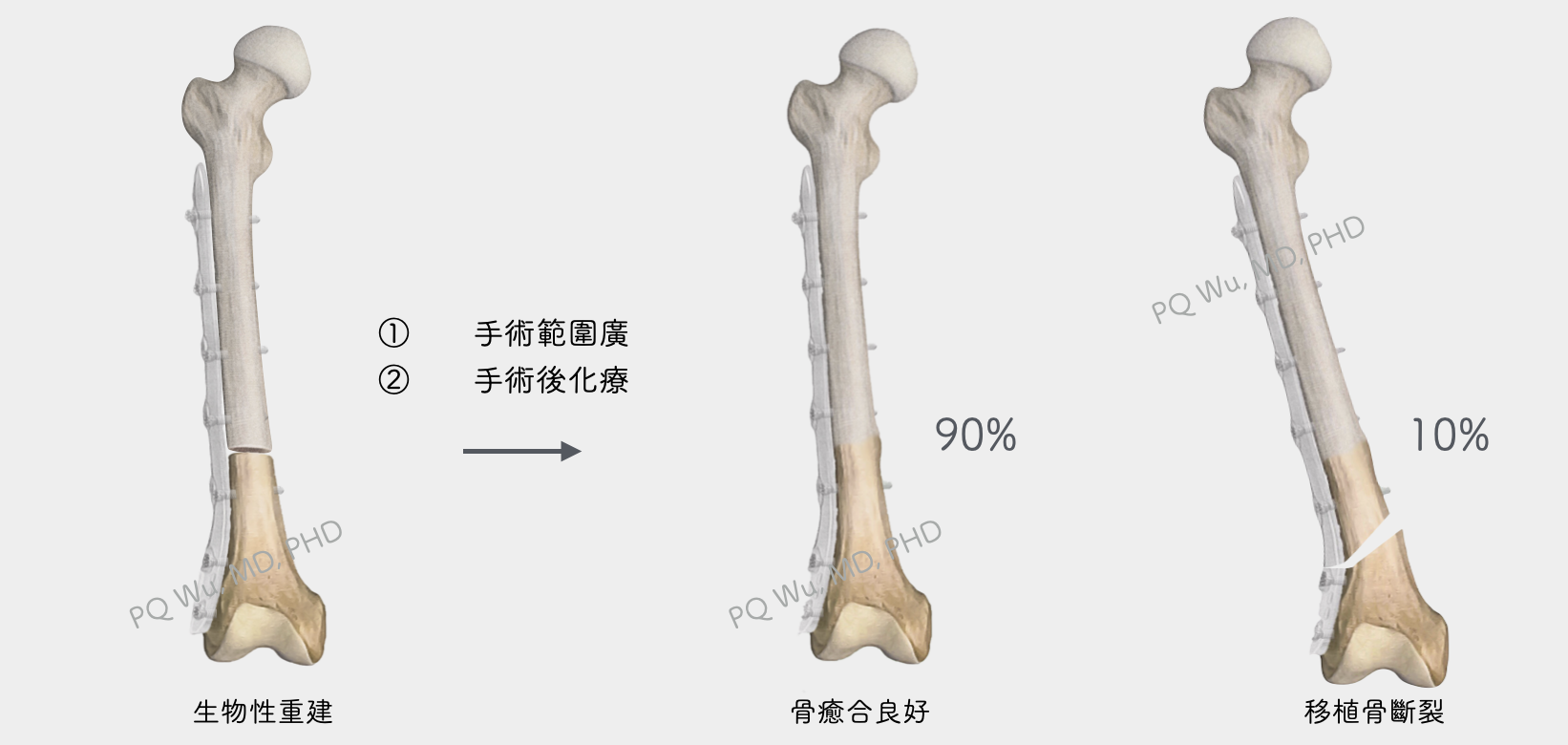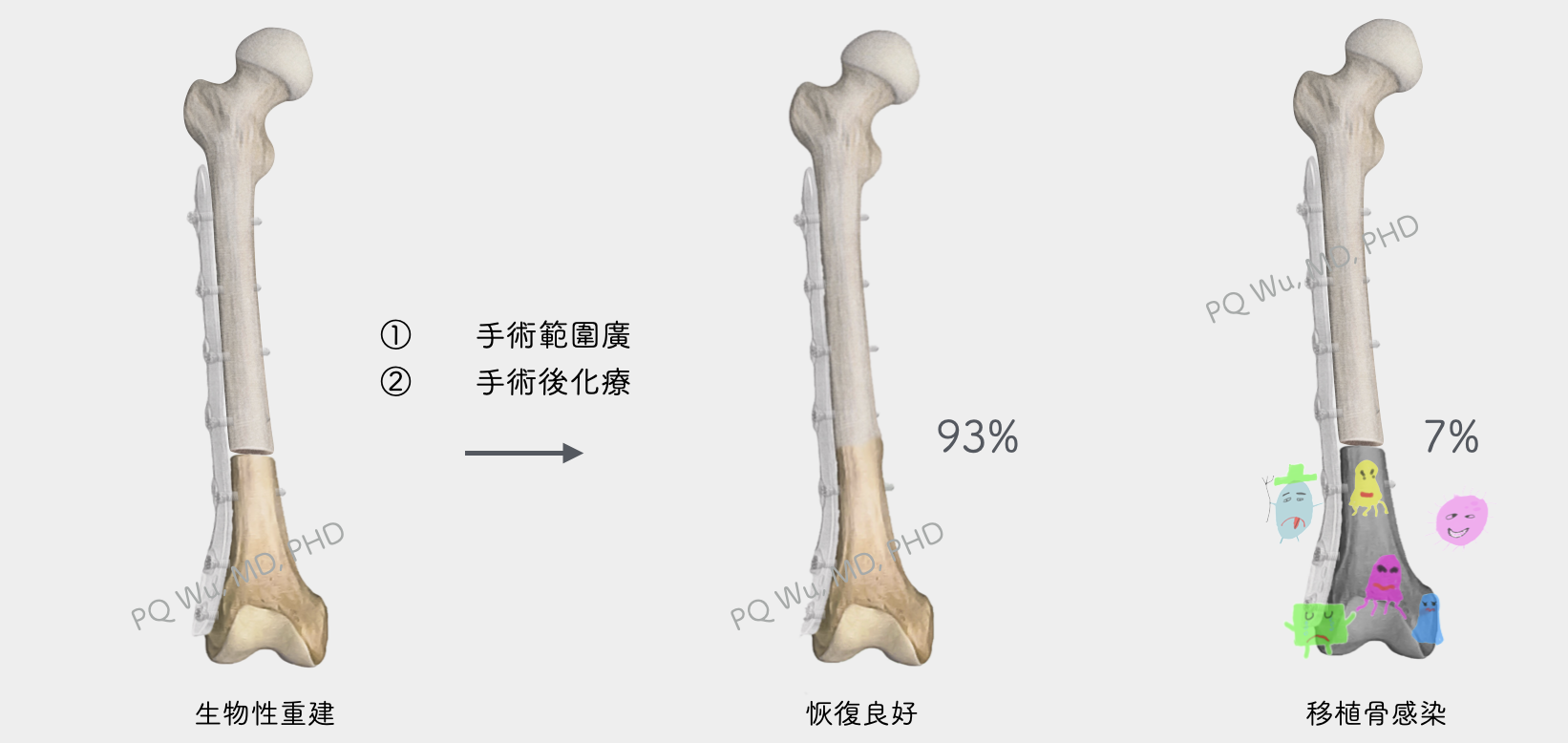In the previous sections, we introduced the advantages and methods of biological reconstruction. We know it’s a very good way to reconstruct bones. However, various types of surgery have problems they cannot avoid, and of course, biological reconstruction has potential complications:
The chance of poor healing is about 5% after surgical fixation in general accidental fractures. Patients with osteosarcoma surgery will need another six to eight months of chemotherapy, generating considerable impact on bone healing. In addition, the recycled autograft and allograft bones lack activated bone cells initially; hence, the healing ability is incomparable to our normal bones. As a result, bones do not heal or heal poorly. According to foreign literature reports, biological reconstruction has about 10-20% of the chance of not recovering and later requires refixation via steel nail and plate and transplantation with autograft bone.
According to a 2016 study by our center, there is an 11.6 percent chance of non-healing or poor healing between the inactivated bones and the patients’ bones. There is a 14% chance of non-healing or poor healing between allograft and patients’ bones. And all these complications of non-healing or poor healing can be treated well by refixation and autograft transplant surgeries.

As mentioned earlier, the recycled autograft or allograft bones lack activated cells after placing in the body. The gradual growth of new blood vessels, importation of stem cells, activation of osteoclasts and osteoblasts must happen in several years so that the bone will be activated. However, during the process, if too much weight or trauma is given to the limb under surgery, fractures can result because the bone's self-healing mechanism is not yet complete. According to our center's 2016 study, autograft bones have a 7.4% chance of concurrent fractures, and allograft bones have a 13% chance of concurrent fractures. In the event of a fracture, a surgical procedure decision must be made per the bone conditions at the time.
If the bone structure is still good, we can carry out autograft transplantation and use steel nails and plates to fix the fracture. It won’t need extensive surgery to replace the allograft bone. If the bone structure is already badly damaged, a new allograft bone is required for replacement. Recently, we have been using bone marrow nails or bone cement in surgeries to strengthen the structure of allograft bones. Currently, the occurrence of fractures in recycled autograft or allograft bone has been greatly reduced! In addition, our center is also conducting a lot of basic research, hoping to promote bone regeneration through stem cells, growth factors, etc. It is hoped that the transplanted bones will be activated more quickly to avoid these complications in the future.

Infection is known to be caused by bacteria invasion in the body. Any surgery is at risk of infection. The general infection rate in orthopedic surgeries is about 2% to 5%. The wider the surgical wound is, the higher the chance of infection. There are several possible causes of infection in recycled autograft and allograft bone:
The first reason is the decrease of patient’s immunity in pre-surgical and postoperative chemotherapy, resulting in white blood cells' incapability to eliminate bacteria during surgery or in postoperative wounds and lead to infection. Also, because of the lack of new blood vessels in the newly transplanted allograft bone, white blood cells cannot be transported to the site. It’s more likely to increase the chance of infection
The second reason is bacteria invade the patient’s body through other common parts such as mouth, urinary tract, or skin. When these bacteria flow in the body, they tend to accumulate (vegetation) in places with less blood flow and fewer living cells, such as artificial joints or recycled autograft, generating local infections.
Infections can be divided into early-stage (within two years of surgery) and late-stage (two years after surgery). Early infections account for about 4.3%, and late infections account for about 2.4%. Most of the early infections can be controlled via surgical clearance and antibiotic therapy. Still, later infections usually require partial removal of the entire transplanted autograft bone, following by months of high local concentrations of antibiotic sterilization before the infection can be controlled for another surgery. Just as tumors are physicians' enemies, bacteria are also our enemies. Hence, we'll think of ways to prevent them from invading.
At present, we can use a high-pressure water spray gun to rinse and clean the wound thoroughly. In addition, a high concentration of antibiotics is placed in the recycled autograft, maintaining the transplant site with a reasonably high level of antibiotics for six months after surgery, thereby reducing the chance of possible wound infection.

However, any surgery can have complications, especially if it is as tricky as limb reconstruction. If doctors and patients fear complications, the easiest way to deal with it is to perform an amputation. However, I think this is not really acceptable at the present level of medical care. What doctors need to do is to understand why these complications occur and what can be done to avoid them? This is also one of the essential tasks in the Therapeutical and Research Center of Musculoskeletal Tumor. Still, this is not just the work of the paramedics. Patients and their families have to 'recognize' the possibility of these complications and try to cooperate with the medical staff to help reduce the occurrence of complications.
Dr. Wu likes to use a metaphor- 'Limb reconstruction' is like cultivating a tree in the courtyard. We can choose to transplant a tree with a trunk that has grown very tall and strong and leaves that are very dense so that we can immediately enjoy the cool and relax under the tree. However, its roots are not deep enough to sustain the strong wind blowing or the huge flood, and the tree will easily fall! We can, on the other hand, choose to transplant a small sapling, and perhaps in the first year, we cannot enjoy the cool under it. However, with everyone’s thorough care every day, its roots will be planted deep, wide, and when the saplings grow up, we do not have to worry about its collapse on typhoon days. So, if you are planting trees today, which one would you choose?



